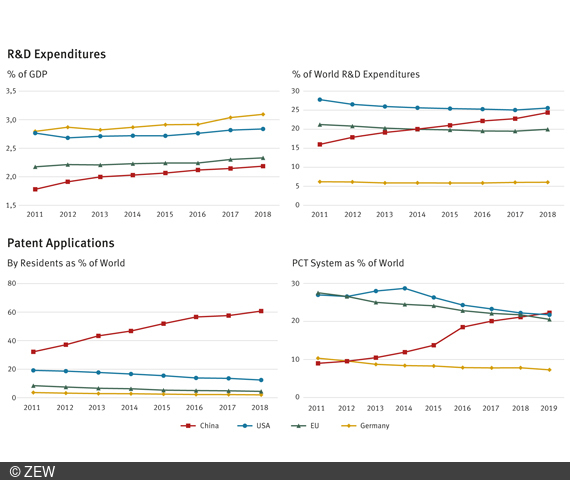China’s Innovative Performance Is Less Sustainable Than Widely Assumed
ResearchThe fourteenth Five-Year Plan (2021–2025) emphasises innovation as the driving force for China’s future economic development with the aim of doubling Chinese GDP and income per capita until 2035. However, a glance at the country’s approaches to implement these economic policy goals reveals a rather mixed picture. On the one hand, China continues to highlight the importance of market-oriented reforms and deregulation; on the other hand, the aim is to achieve economic and technological self-sufficiency under government leadership. A recent ZEW expert brief explains how previous economic-policy measures have impacted on Chinese innovative and economic output. This expert brief marks the beginning of a series of publications by researcher Philipp Boeing and his team who jointly present their research findings on China’s innovation activity.
“China’s innovative and economic performance is less outstanding than often perceived, and there is still a long way to go before it reaches the status of a high-income country,” says Dr. Philipp Boeing, researcher in the ZEW Research Department “Economics of Innovation and Industrial Dynamics”. According to the expert brief, China’s productivity growth fell by more than a half after the global financial crisis and the current productivity level merely equates to a third of that of the USA. In the manufacturing industry, existing enterprises contribute to efficiency gains to a large extent. Nevertheless, productivity growth is still on the decline due to misallocation and market entry and exit that is distorted by policy.
China’s innovation policy is sometimes effective but seldom efficient
Increased innovation activity should now make China’s economy more efficient. On a global scale, China currently accounts for approximately a quarter of research and development (R&D) expenditures and is leading in both domestic and international patent applications. Although this increase has not been able to prevent the decline in productivity growth in China, it has most likely cushioned an even sharper fall. However, the question remains whether this trend will continue into the future. The uptake of existing ideas and technologies means that not only is China’s distance to the global technology frontier diminishing, but also future returns to R&D, whilst barriers to accessing foreign advanced technology are currently increasing. The adoption of an explicitly mission-oriented policy aimed at achieving economic and technological self-sufficiency could have further harmful consequences. This is because government support often benefits national key and prestige projects that sometimes prioritise national security over economic considerations. Moreover, the Chinese government could also simply be wrong in their choice of future technologies, which would entail huge opportunity costs from an economic perspective.
Market-orientated reform as a chance for Chinese innovation
“Industrialised countries that find themselves exposed to greater competition from China should avoid premature conclusions that link China’s apparent technological prowess to its industrial policy and national champions,” argues Philipp Boeing. “If anything, the evidence suggests that economic achievements were realised not because of excessive government involvement, but despite such interventions.” China’s government subsidies also decrease private investments in its own innovation system and have so far not contributed to long-term productivity growth. In light of these issues and the measures aimed at boosting the number of patent applications, which have led to a disproportionate increase in patents of inferior quality, Boeing concludes: “China’s innovation policy is sometimes effective but seldom efficient.”
Boeing therefore argues the case for further market-orientated reforms, where he sees advantages for both the Chinese economy as well as foreign countries and companies. These reforms should also ensure fair market competition. “The conception and implementation of the forthcoming ‘National Medium- and Long-Term Science and Technology Development Plan 2021–2035’ will detail further innovation goals and supporting policies,” Boeing says.

